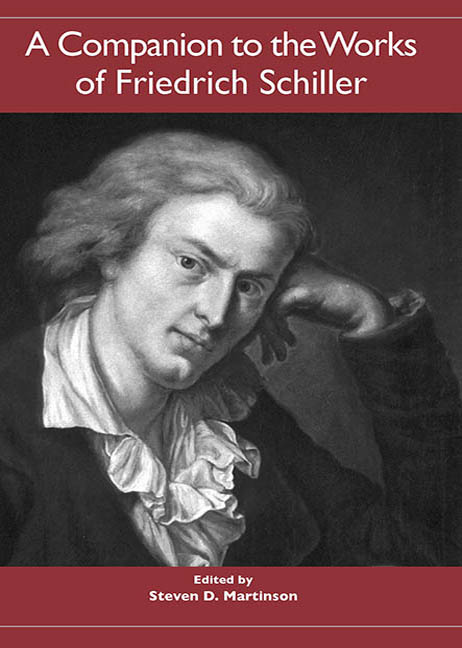Book contents
- Frontmatter
- Dedication
- Contents
- Acknowledgments
- The Works of Friedrich Schiller
- Editions and Abbreviations
- Introduction: Schiller and the New Century
- Intellectual-Historical Settings
- Schiller's Philosophical Aesthetics in Anthropological Perspective
- Schiller and Classical Antiquity
- Schiller the Historian
- Major Writings
- Schiller's Legacy
- Works Cited
- Notes on the Contributors
- Index
Schiller the Historian
from Intellectual-Historical Settings
Published online by Cambridge University Press: 28 April 2017
- Frontmatter
- Dedication
- Contents
- Acknowledgments
- The Works of Friedrich Schiller
- Editions and Abbreviations
- Introduction: Schiller and the New Century
- Intellectual-Historical Settings
- Schiller's Philosophical Aesthetics in Anthropological Perspective
- Schiller and Classical Antiquity
- Schiller the Historian
- Major Writings
- Schiller's Legacy
- Works Cited
- Notes on the Contributors
- Index
Summary
Friedrich Schiller was Twenty-Eight years old when, after having enjoyed sensational success as a dramatist, he decided to set aside his creative poetic work to devote himself entirely to the writing of history. Resigning his post as a military doctor in Stuttgart in September 1782 left Schiller without a steady income and heavily in debt. As a historian he gained new intellectual perspectives, social connections, and sources of income. In 1785 Schiller moved from southwest to central Germany and soon became a noted partner in the flourishing book and newspaper industry. Already well known as a dramatist, as a writer he encountered personal engagement and intellectual interest within socially open-minded literary and artistic circles in Leipzig, Dresden, Jena, and Weimar. Supported by the young Leipzig-based publisher Georg Joachim Göschen, he was able to continue the journal Thalia, which he had begun in Weimar. In the second issue of the magazine, in February 1786, the second act of Don Carlos appeared. It was the last drama of Schiller's early phase, as well as his first historical prose text.
Schiller's decision to write history ripened while working on the project Geschichte der merkwürdigsten Rebellionen und Verschwörungen (History of the Most Remarkable Rebellions and Conspiracies, 1788) concerning the Dutch rebellion against Spain in the sixteenth century, which he had been carrying out with a close friend of his, Ludwig Ferdinand Huber, since 1786. The encouragement of the prominent Weimar writer Christoph Martin Wieland in the fall of 1787 was critical. Wieland suggested to Schiller that he expand his piece on the Dutch “rebellion” into a scientifically-based description. One year later the first volume of Schiller's history became available and secured for him a reputation as an excellent historian: Geschichte des Abfalls der Vereinigten Niederlande von der spanischen Regierung (History of the Revolt of the Spanish Netherlands, 1788/1801).
The young historical narrator became courageous. He threw himself immediately into a new project that was now also supported by his friend in Dresden, Gottfried Körner: the publication of an Allgemeine Sammlung historischer Memoirs vom zwölften Jahrhundert bis auf die neuesten Zeiten (General Collection of Historical Memoirs from the Twelfth Century to Today, 1791–1806). In this subsequent work, at least four volumes of personal memoirs from European history since the Middle Ages were to appear annually. Schiller accepted the task of writing an introductory historical overview for every volume.
- Type
- Chapter
- Information
- A Companion to the Works of Friedrich Schiller , pp. 67 - 86Publisher: Boydell & BrewerPrint publication year: 2005

